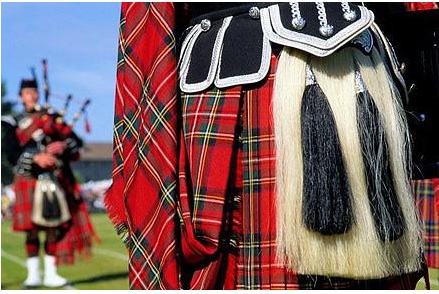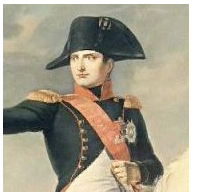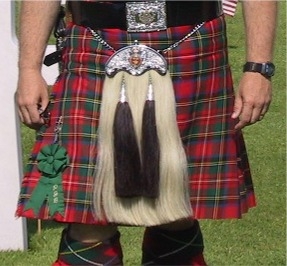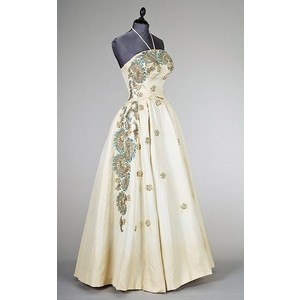A sporran which is Gaelic for purse, is a pouch worn with the male traditional Highland dress. The kilt has no pockets and so the sporran was designed for that function.
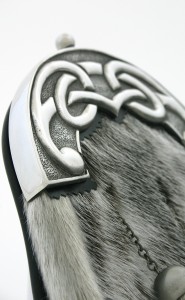 Made of leather or fur, the ornamentation of the sporran is determined by the formality of dress. The sporran is worn on a leather strap or chain, conventionally positioned in front of the wearer over the groin area. It hangs below the belt buckle and much effort is made to match their style and design.
Made of leather or fur, the ornamentation of the sporran is determined by the formality of dress. The sporran is worn on a leather strap or chain, conventionally positioned in front of the wearer over the groin area. It hangs below the belt buckle and much effort is made to match their style and design.
The kilt belt buckle can be very ornate and match motifs on the sporran. Early sporrans may have been worn suspended from the belt, rather than hung from a separate strap in front of the wearer.
Since the traditional kilt does not have pockets, the sporran serves as a container for any other necessary personal items and also as a wallet. It is essentially a survival of the common European medieval belt-pouch, superseded elsewhere as clothing came to have pockets. However it continues in the Scottish Highlands because of the lack of these accessories in traditional dress.
The sporran can be turned around the waist to let it hang on the hip in a more casual position when doing anything too energetic. A heavy pouch can become cumbersome.
As sporrans are made of animal skin, their production, ownership and transportation across borders can be regulated by legislation set to control the trade of protected and endangered species.
Most common sporran skins are not controlled or regulated animals in regards to this legislation.
Sporrans are seen as more than a piece of practical clothing and there are many designed for different occasions. There are day and dress sporrans also reflecting the clans of the Higlands.
The sporran is an important part of Highland Dress, and as such, should be of the highest standard.
Sporrans in the Highlands were traditionally made from leather or doeskin but since the 18th century materials such as sealskin, and all kinds of furs, have become increasingly popular.
The modern sporran comes in three styles:
- Day – an all leather sporran with a flap top, normally worn on informal day events.
- Semi Dress – made of leather and fur with a leather flat top, this is more casual than a dress sporran and is often worn with Tweed or Argyll jackets at day events.
- Dress – made of animal fur with a curved metal top called a Cantel. This style is normally worn to evening events with a Prince Charlie jacket. Dress sporrans are worn to all sorts of occasions and are very popular at weddings and balls.
Choosing the right sporran is really down to the personal taste and preference of the individual. Some people prefer a natural or black fur sporran as it is more subtle, others favour bright colours such as purple or red.
A good sporran should be made by a reputable company in Scotland (many are now being made in over seas) and should be made from the best grade of animal skin, leather and metal fittings.
the sporran, as we know it today, is a relatively ‘modern’ and largely decorative addition to Highland dress. The outfit of long ago was the belted plaid, where a purse made of deerskin or calfskin was attached at the waist, often at the side, to carry money or personal items.
With the arrival of the ‘little kilt’ in the Victorian era, the impracticality of not having trouser pockets was overcome by stringing a small leather bag over the hips to hang in front. A leather belt of chain is usually employed, fastening at the rear of the wearer.
Most modern kilts have loops at the back through which belts or sporran chains can be threaded.
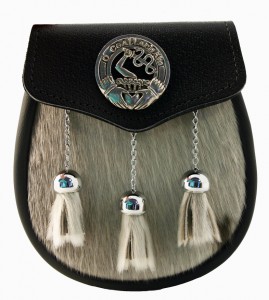 When wearing a kilt during the day at a Scottish gathering or wedding, it is customary to wear a tweed jacket and make use of a plain, unpretentious sporran of brown or black leather. These can be flat and tooled, or take the form of a baggy pouch. The flat version sometimes has celtic knots embossed upon it, and often there are three leather tassles attached to the front.
When wearing a kilt during the day at a Scottish gathering or wedding, it is customary to wear a tweed jacket and make use of a plain, unpretentious sporran of brown or black leather. These can be flat and tooled, or take the form of a baggy pouch. The flat version sometimes has celtic knots embossed upon it, and often there are three leather tassles attached to the front.
The hand-sewn, more traditional Rob Roy sporran, baggy and tied at the opening with a drawstring, sometimes contains a small purse within it. This style is particularly ideal for carrying a small flask of Scotch whisky.
Never underestimate what a Scotsman keeps in his sporran! An 18th century sporran on display at the National Museum of Scotland in Edinburgh features a clasp of brass and steel concealing four pistols inside.
In the best James Bond tradition, this remarkable contraption was a protective measure against anyone unauthorised to open the locked purse. On being shown it, Sir Walter Scott was sufficiently inspired to make use of it in his 1812 novel Rob Roy, where Rob Roy MacGregor declares: “I advise no man to attempt opening this sporran till he has my secret.” Evening dress sporrans, worn with silver buttoned Prince Charlie coatees or Montrose jackets, are always infinitely more ornate, and sometimes the decoration is carried to extremes. As Highland dress became increasingly popular for eveningwear during the Victorian era, some sporrans were even embellished with cairngorms and garnets. It seems our ancestors delighted in real fur (otter, badger, seal and fox) with engraved silver cantles or surrounds showing clan crests or thistles, and silver topped tassles.
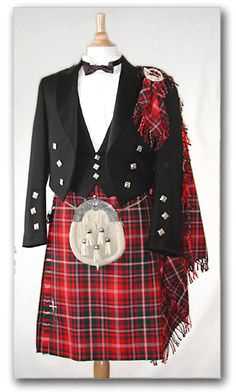 With sensitivities over the fur trade, these are nowadays only available as antiques.
With sensitivities over the fur trade, these are nowadays only available as antiques.
In June 2007, the Scottish Government introduced legislation to protect endangered species whose skins have been traditionally popular with sporran manufacturers.
Bringing Scotland in line with other European Union countries, the law only applies to animals killed after 1994.
Some manufacturers have since launched ranges using fake fur, but sham zebra or tiger pattern sporrans are perhaps taking it a bit too far.
The emergence of the traditional sporran in all its glory, however, can be attributed to the military, where the kilted Scottish regiments developed their own individual styles. The most flamboyant sporrans are worn by the Scottish regimental pipe bands, and are famous the world over. These ‘sporans molach’ (hairy sporrans) are invariably fabricated in black and white horse or goat hair which swishes from side to side as the piper marches. With their regimental associations, it is not considered appropriate for these sporrans to be worn by civilians, but this has not prevented them from turning up as fashion accessories at football matches.
A warning! Sporrans should not be worn too low on the kilt, to be precise, no less than a couple of inches below the waist. If, however, you are planning to dance or take violent exercise, it is suggested that the sporran be worn a few inches lower in order for the chain and weight to prevent the kilt from flying up and revealing what you are or are not wearing underneath.
Credits:

